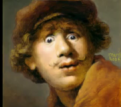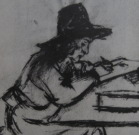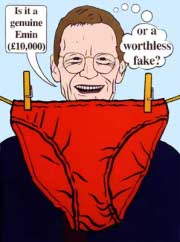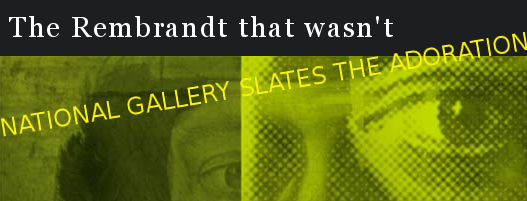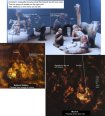| Pros and Cons |
|
Post Nigel Konstam Posted July 18th 2005
PROS & CONS It should be noted that the cons are all Rembrandt scholars who have a great deal to lose by accepting the new facts: loss of face, loss of expertise, of status for their profession and perhaps of their livelihood, because I estimate their “expertise” as worse than useless – as very positively harmful. In my long experiences of talking about Rembrandt; I did once find another uncommitted contra: a very elderly uncle, a good amateur painter and a lover of Rembrandt who said he would prefer to go on thinking of Rembrandt with a vivid imagination. I can sympathize with that point of view but for those like him who would also prefer Rembrandt that way, I would ask you to consider the terrible consequences as outlined in this website. PROS 1. Benedict Nicholson (editor of The Burlington Magazine) on accepting my article “I find the evidence you have accumulated of the greatest possible interest, and so I am sure will Rembrandt scholars, who must now get down to revising the corpus of drawings!” 2. about my exhibition at Imperial College Prof. Bryan Cole wrote (in Icon, the magazine of the college) “Not only do these reconstructions (many of which compel assent) cast doubt on received wisdom as far as the dates are concerned: they also imply that a view of Rembrandt's imagination's construction as depending only on the inner eye becomes very difficult to sustain. I find myself totally convinced by Mr. Konstam's arguments here. His feeling for the materials of the artist's work is very strong and it would be a pity for scholarship not to profit from his imaginative researches.” 3. Max Wykes-Joyce, (The International Herald Tribune)...”certainly the exhibition is a seminal one that should not be lightly dismissed.” Nigel Hawkes (The Observer, 23 Nov. 1975) head-lined his long illustrated article “The Rembrandt Revelation” 4. those were press comments, I also received Letters of Appreciation of the exhibition from Dr. M.Kauffman (of the Victoria and Albert Museum) “You certainly make a pretty convincing case for the Rembrandts” 5.Prof M.Podroe (prof of Art History) “I am a great admirer of your whole project... your evidence is of immense importance and critical finesse” 6. after one of my lectures at the Slade Prof. Sir Lawrence Gowing wrote “your division between objective and imaginative seems to me artistically and psychologically much more comprehensible and satisfactory than anything before”. 7. In his opening address to my second Imperial College exhibition Prof. Sir Ernst Gombrich said “Konstam has prepared a great feast for art historians at which he invites them to eat their own words.” 8. in a very long and useful article Anthony Bailey (The New Yorker March, 5th 1990) wrote, “An English sculptor, who is a student of Rembrandt's drawings has written to Bruyn and van der Wetering, “ I find Rembrandt hugely more variable than your team will allow. I can give very many instances where the quality of the work of a single sheet, all clearly by Rembrandt himself, varies from exquisite to poor, by any standards. In spite of this fluctuating quality, I find my Rembrandt is not only a far more prolific artist but is more interesting and has far more to teach us, perhaps because he is more human (and, incidently, closer to the artist revealed by the documents).” in his book (Rembrandt's House) Anthony Bailey wrote (page 213-215)“Nigel Konstam, the English sculptor I have mentioned before (on pages 99-100) has suggested that most of these Biblical sketches were done from life, using students and models posing in his studio. ... This means, if Konstam is right ( and he has made extremely convincing models and illustrations to back up his theory), that drawings on one subject, that scholars have dispersed to various periods may well have been done at the same time.” And a lot more besides which you already know if you have studied the website. CONTRAS 1. I wrote an article on my discoveries with the help of a friend from the British Museum prints department. He submitted it to a colleague, Christopher White, who was the Rembrandt specialist there. After months of waiting it was handed back with the comment “It would be very important if he could prove it”. 2. NK. Then, as now it was proven - beyond reasonable doubt. 3. The Observer did an article on the discoveries, with the intention that I should answer the objections with a second, colour supplement article. The objections never came, therefore no second article. 4. I gave an exhibition at Imperial College, which was very well received (see PROS). The article was accepted with Gombrich's and Montagu's improvements by the Burlington Magazine. Again there were no objections raised against the article which must have disturbed very many.(Feb.'77) 5. I gave many talks at art colleges but only two (at Birkbeck and Reading) to students of art history, in spite of many letters to heads of departments. 6. I gave a second exhibition at Imperial College which had yet more revelations, about Vermeer, Velasquez, Poussin, Martini and Masaccio. It got no reviews at all. 7. For the next two years I was fully occupied with exhibitions in Spain. 8. On my return from a triumphal tour (as a sculptor) it became quite clear that the silence from the art historians and media critics was complete. Within a year I decamped to Italy where I now live and run The Verrocchio Arts Centre (www.verrocchio.co.uk). Rembrandt is not a foreground figure here. 9.A few friendly letters were exchanged with Mr. Royalton Kisch who was preparing a new catalogue of the Rembrandt drawings at the British Museum. He then sent me the draft of his entry for the lady B314 (See the last page in the Imagination section of this site). I immediately wrote back pointing out his mistakes but the draft version appeared in the final catalogue (p.70) 11 months later. 10. It reads - “Without denying the similarity in the pose in the two drawings, the ingenious theory that a mirror was used and the figure drawn twice from a single vantage point, proposed by Konstam, 1977/78, p.92/28 seems to go too far and is contradicted by the position of the table in the present sheet, of the right hand and the left arm (indeed the arms though not the cloth should be reversed), by the position of the artist beyond the table in the Haarlem sheet and of the shadow behind the figure in the British Museum's drawing. Objections have already been raised by Borsum Buisman, 1984.” 11. NK. The shadow and the artist are reasonable objections, the rest is just plain nonsense. I think we can all agree that the artist's head could have been drawn by any talented teenager in the margin of an exercise book, the less said about the shadow the better, it is not worth refuting. I again draw your attention to the huge difference in quality between the two drawings, that Mr. Royalton Kisch cannot see.(I guess most of you can see it on the computer screen, he has the real thing to look at).Do not be over-awed by the face, our teenage doodler can do as well; look at the clothes. As for the table he thinks it is masking the lady's left hand! We have got to admit he is ingenious but he is playing games with a most important part of our artistic inheritance. 12. On page 72, he writes of The Drummers, “ As noted by C.White in the museum's files . The many differences between the two figures undermine the theory proposed by Konstam 1977/78 that a single model was posed by a mirror, the further figure being his reflection. Nor is the model necessarily the same as in B366” (The Musicians). A LINK? 13.NK. If the “theory” rested on the drummers alone perhaps it would be slightly undermined by the minor differences between the figures but what about the eleven other obvious examples you can find in the same Volume II of Benesh's catalogue?( no. B.209, 211, 211a, 212, 230, 305, 314, 315, 361, 365, 366, 368.) I would not make this fuss about a private theory; this is fact until some other better explanation can be found for the evidence I put before you. I have a letter from the Rembrandt specialist at Yale,Prof. Haverkamp-Begemann. He suggests that what I have really discovered is the three dimensional nature of the 17th century imagination! Something a bit better than that , please. At the time I was looking for a publisher of my book on Rembrandt (still unpublished) he suggested I should write a book about that! 14. The scholars pick away at silly little objections in a place where I have no right of reply, and keep silent when I can reply. Can this be tolerated in a democratic society? Its been going on for 31 years, Thank God for internet. 15. On page 97 Royalton-Kisch lines up a third expert witness P. Schatborn of the Rijks Museum to subdue Konstam. Schatborn had recently de attributed a Rembrandt drawing I used as the first example in an article that he had translated for The Rembrandthuis Kroniek! He did the same with the “1656” version of The Dismissal of Hagar. 16. NK. very clever stuff! We the tax payers of Britain and Holland pay their salaries. I could go on, and on, and on, but I fear I might bore you. Though my work has been published several times since The Burlington Mag Feb. 1977 it is not discussed in departments of art history probably because there is no answer other than to retreat by the established Rembrandt scholars. How do we move from here? NK |




